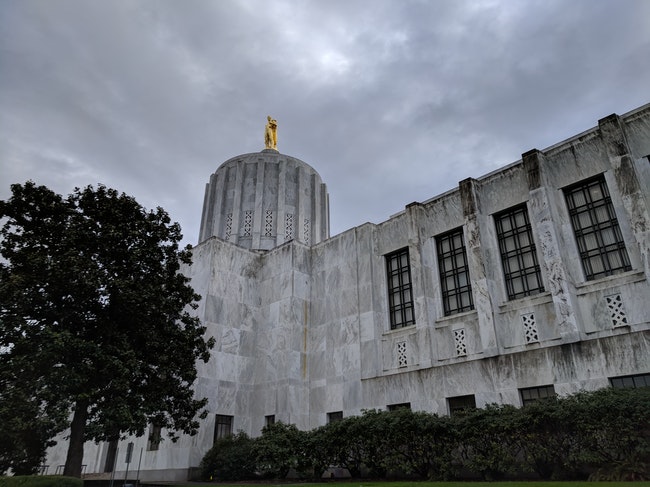 The Oregon Capitol building in Salem. Photo: Chas Hundley
The Oregon Capitol building in Salem. Photo: Chas Hundley
An updated brief from the Oregon Legislative Fiscal Office originally released in May and re-released in September shows the state will spend $400 million of Education Stability Fund (ESF) money to pay for losses resulting from the COVID-19 shutdown.
State records show $400 million is the most lawmakers ever have used from the ESF, money set aside originally for education that came from 18 percent of the net proceeds of the state lottery.
The 2009 legislature used $393.8 million, the entire ESF budget then, to rebalance the budget during The Great Recession; the state chambers also transferred $126.5 million to the State School Fund during the 2003-05 biennium.
In fact, there has been no spending from the ESF since the 2011-13 legislative term, when the amount in the fund totaled $7.4 million. As of June 2020, the state Office of Economic Analysis current ESF balance is $732.9 million, and was projected to grow to $800.1 million by the end of the current biennium in 2021.
“Oregon’s two budget reserve funds, (which includes the Oregon Rainy Day Fund [ORDF]), has been used to continue programs and services during economic downturns, to stabilize and improve the state’s bond rating in the credit markets, and to serve as a hedge against cash flow deficits at the state level,” the fiscal office brief states.
 Help us increase our 2020 election coverage with a digital subscription, featuring a $10 discount now through November 3 for an annual subscription. Monthly plans are $8/month. Click here to start
Help us increase our 2020 election coverage with a digital subscription, featuring a $10 discount now through November 3 for an annual subscription. Monthly plans are $8/month. Click here to start
The brief goes on to state that the state’s two reserve funds, the ESF and ORDF — think of them as Oregon’s savings accounts — are projected to total about $1.75 billion at the end of 2021, without adjustment for any possible future losses.
Voters established the ESF in 2002 when they amended the Oregon Constitution to create a reserve fund from an already-set-aside education endowment, which consists of 18 percent of the net proceeds from the state lottery.
The law states that 18 percent is to be capped at 5 percent of the amount accrued in general fund revenues during the prior biennium. Fifteen percent of net lottery proceeds would be deposited into a reserve known as the School Capital Matching Fund, which according to the state constitution is supposed to provide matching funds from the state to school districts that have received voter approval to finance capital costs for bond measures.
But Oregon has never reached the 5 percent threshold — many argue this is because of Oregon’s kicker law — triggering a provision in the law that allows the state legislature to spend ESF principle on public education during an economic downturn, as long as expenditures are approved by a three-fifths vote by members of both the Oregon House and Senate.
On a side note, there also exists within the ESF is another fund called the Oregon Growth Account (OGA). The OGA consists of 10 percent of the funds transferred to the ESF by the state lottery, which accounts for about 1.8 percent of all lottery proceeds. Money in the OGA primarily is used to provide seed capital for Oregon venture and emerging-growth businesses.
Business Oregon, which is what the state calls its business development agency, reported $55.3 million in OGA investment earnings so far had been given to the Oregon Education Association and to the Oregon Opportunity Grant program.
The ESF Fund also may be used to pay for lottery-bond debt, up to 75 percent of it, and the state expects to have paid off the remaining balance by the end of 2019-2021 biennium, the Legislative Fiscal Office brief said.



